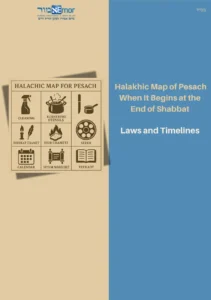
Halakhic Map of Pesach - Laws & Timelines
An essential overview for when Erev Pesach falls on Shabbat.
CHAMETZ – THE CENTRAL PROHIBITION
What is Chametz?
Chametz is any food product made from wheat, barley, oats, rye, or spelt that has leavened (fermented) for 18 minutes or more. It includes bread, cakes, cookies, pasta, and beer.
Three Torah Prohibitions:
- Bal Yera’eh: One may not see chametz in their possession during Pesach.
- Bal Yimatzeh: One may not own chametz during Pesach.
- Akhilat Chametz: One may not eat chametz during Pesach.
Disposal of Chametz:
- Bedikat Chametz (Search): Done on the night of the 14th of Nissan (Thursday night if Erev Pesach is Shabbat), using a candle (or flashlight). A berakha is recited before the search.
- Bi’ur Chametz (Burning): Performed the following morning before the 6th halachic hour. If Erev Pesach is Shabbat, bi’ur chametz is done Friday morning.
- Bitul Chametz (Nullification):
- Recited twice; the first declaration is said after the search.
- The second is recited after the burning – or on Shabbat morning (when Erev Pesach falls on Shabbat) – after disposing of any remaining chametz.
🔗Link to Bedikat & Bi’ur Chametz guide
Mekhirat Chametz (The Sale of Chametz):
Chametz that cannot be consumed or destroyed before Pesach is sold to a non-Jew via a rabbi, through a formal legal sale. When Erev Pesach is Shabbat, this sale is completed by Friday morning.
PREPARATIONS BEFORE PESACH
Cleaning the Home:
All rooms, especially those where food is eaten or stored, must be cleaned thoroughly of chametz.
🔗Link to Pesach cleaning guide
Kashering the Kitchen:
Utensils and surfaces that will be used for Pesach must be kashered properly. The method depends on how each item is normally used (direct heat, liquid, etc.).
Friday Preparations (When Erev Pesach is Shabbat):
- All Pesach preparations should be completed before Shabbat begins.
- This includes cooking, kashering, and Seder preparations (e.g., roasting the zero’a and egg, washing lettuce, grating horseradish, preparing charoset).
EREV PESACH ON SHABBAT
🗓️ THURSDAY, APRIL 10, 2025
TA’ANIT BEKHOROT – FAST OF THE FIRSTBORN
It commemorates Hashem’s sparing the firstborn sons of the Israelites during the Tenth Plague in Egypt, when all Egyptian firstborns were struck down.
- Why it is observed earlier this year:
Since this year Erev Pesach falls on Shabbat, the fast would normally fall on Friday. However, fasts are generally not observed on Fridays (except in rare cases), so Ta’anit Bekhorot is observed on Thursday instead.
WHO FASTS, WHEN, AND WHAT TO DO
WHO FASTS?
- A firstborn male who is the first to open his mother’s womb (peter rechem) is obligated to fast. Likewise, a firstborn male from the father’s side is also obligated to fast.
- If the firstborn is a child, his father fasts on his behalf.
WHEN TO FAST?
- The fast is normally observed on the 14th of Nissan, but when Erev Pesach falls on Shabbat, it is moved earlier, as mentioned above.
HOW IT IS OBSERVED:
- Though it is technically a fast day, the widespread custom is for firstborns to attend a siyum—the festive completion of a Talmudic tractate—which exempts them from fasting for the remainder of the day.
🗓️ THURSDAY NIGHT
- Bedikat Chametz
To be done on Thursday night, starting at nightfall, once the stars appear. By that time, all cleaning must be completed in any area that may have contained chametz during the year.
- Care must be taken to set aside any chametz needed for the next day, so it is not lost.
🔗Link to Bedikat & Bi’ur Chametz guide
🗓️ FRIDAY, APRIL 11, 2025
- Bi’ur Chametz – Burning of Chametz
Chametz should be burned by the end of the fifth halachic hour on Friday, approximately 11:35 AM, keeping aside only the bread needed for Friday night and Shabbat morning meals. After eliminating the chametz, the Kol Chamira nullification is not recited at this time; it will be recited on Shabbat morning, by 11:35 AM.
- Sale of Chametz
The sale of chametz is typically completed by 11:35 AM on Friday. One should consult the designated rabbinic authority for the precise time at which the sale will take place
- Beginning of Shabbat
All Seder food preparations should be completed before candle lighting on Friday, as no festival preparations are allowed on Shabbat, and to avoid delaying the start of the Seder on Saturday night.
- It is recommended to put away all chametz dishes and utensils by Friday morning. For all of Shabbat, one should use disposable plates, cups, and cutlery, since chametz bread is eaten Friday night and Shabbat morning (except for those using the alternative options mentioned below), but the rest of the food is already kasher lePesach.
🗓️ SATURDAY, APRIL 12
It is forbidden to eat matza from dawn onward, and chametz from approximately 10:30 AM (some say 10 AM).
Meal Guidelines
For the first two Shabbat meals—Friday night and Shabbat morning—it is a mitzva to eat bread, which creates complications when Shabbat coincides with Erev Pesach. The recommended approach is as follows:
- On Friday night, serve only kasher lePesach food, except for the bread. Use disposable plates and utensils, and eat approximately 60 grams of bread, taking care not to scatter crumbs.
- The bread eaten at the Shabbat morning meal must be finished by approximately 10:30 AM (some say by 10:00 AM), after which eating chametz is forbidden. It is advised to eat the bread on a small table or cart covered with disposable paper or a separate disposable tablecloth. Alternatively, one may recite Kiddush and eat bread in one’s yard or other room, with the intention to continue the meal in the dining room. One may continue eating the rest of the kasher lePesach foods after this time and recite Birkat Ha’mazon in the second location.
- Some have the custom to avoid actual bread at the Shabbat meals and instead use egg matza or matza ashira (matza made with fruit juice). Another option, permitted by some halakhic authorities, is to prepare matza before Shabbat in a way that alters its form—such as cooking it in broth for a few minutes and letting it dry intact, or frying it whole without breaking it. According to these opinions, this avoids the prohibition of eating matza on Erev Pesach, as it is no longer in its original form and is thus not fit for the Seder.
- Shabbat Shacharit
To allow time for the morning meal before the deadline, Shacharit (morning prayer service) is typically held early and concluded quickly. If there is not enough time after it is completed to eat bread, Kiddush may be made immediately after Shacharit, even before the Torah reading, and up to 60 grams of bread should be eaten at that time. The rest of the meal may be held later.
- Elimination and Nullification of Chametz
Any crumbs or leftover chametz must be removed from the house or disposed of by flushing down the toilet by approximately 11:30 AM. The second Kol Chamira nullification must also be recited at this time.
- Se’uda Shelishit
It is recommended to eat Se’uda Shelishit by the tenth halakhic hour, approximately 3:50 PM, using cooked dishes made of matza meal, such as matza balls. Sephardim and some Ashkenazim also permit eating egg matza or matza ashira until this time. If Se’uda Shelishit is eaten after this time, one may still eat other non-grain foods, including eggs, fish, chicken, fruits, vegetables, and any baked dishes made from potato starch.
🕓 All times given in the guide are approximate and may fluctuate somewhat based on location. For precise local halachic times, consult a reliable Jewish calendar, here, or your community’s rabbinic authority.
- Candle Lighting – Motzaei Shabbat
On Saturday night (Motzaei Shabbat), Pesach candles are to be lit only after nightfall, using a flame that has remained lit since before Shabbat.
THE SEDER NIGHT (Motzei Shabbat)
After Shabbat Ends:
- Say “Barukh Ha’mavdil bein kodesh lekodesh” before starting any preparations.
- Light Yom Tov candles from a pre-existing flame.
- Set the Seder table.
Kiddush and Havdalah – Yaknahaz:
- The order is: Yayin (wine), Kiddush (berakha of “Mekadesh Yisrael Vehazmanim”), Ner (candle, berakha of Borei Me’orei Ha’esh), Havdala (berakha of Havdala), and Zeman (Shehecheyanu).
- For Borei Me’orei Ha’esh, use the Yom Tov candles alone or join a match to one of them.
Changes in the Haggada for Saturday Night
- In the berakha recited at the end of Magid, many reverse the normal order of the words “min ha’zevachim umin ha’pesachim” to “min ha’pesachim umin ha’zevachim since when Pesach falls on Saturday night, the “zevachim” (the chagiga offering) was only offered in the Beit Ha’mikdash on the following day, after the “pesachim” (the Korban Pesach).
CHOL HA’MO’ED (INTERMEDIATE DAYS)
Work Restrictions:
Certain types of work are prohibited unless necessary for Yom Tov needs or to prevent financial loss. Ask a halakhic authority as needed.
Simcha and Activities:
These days are for spiritual growth, family time, and simcha (rejoicing). Matza is still eaten (though not obligatory if one prefers not to eat it), and chametz remains forbidden.
LAST DAYS OF PESACH
The 7th Day:
Commemorates Keriat Yam Suf (Splitting of the Sea). Full Yom Tov with festive meals, prohibited labor, a special Torah reading, and Hallel.
The 8th Day (in the Diaspora):
- Yizkor is recited.
- Some hold Moshiach’s Se’uda in the afternoon, with stories and singing about redemption.

